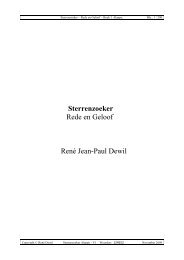A visual Journey into the Bible The Book of Genesis
A visual Journey into the Bible The Book of Genesis
A visual Journey into the Bible The Book of Genesis
Create successful ePaper yourself
Turn your PDF publications into a flip-book with our unique Google optimized e-Paper software.
A Visual <strong>Journey</strong> <strong>into</strong> <strong>the</strong> <strong>Bible</strong> Page: 50<br />
Henriques were considerable as can be seen from this picture. He could compete with<br />
<strong>the</strong> best nor<strong>the</strong>rn artists <strong>of</strong> Gothic. Remark <strong>the</strong> full splendid detail <strong>of</strong> <strong>the</strong> figures, all<br />
<strong>the</strong>ir different faces and attitudes. All gowns are depicted in <strong>the</strong> rich courtly style <strong>of</strong><br />
Gothic. Abram’s armour is rendered with great mastery <strong>of</strong> <strong>the</strong> various patches <strong>of</strong><br />
brightness and shadows that generate <strong>the</strong> volume <strong>of</strong> <strong>the</strong> forms. Remark <strong>the</strong> brocade<br />
and lines <strong>of</strong> <strong>the</strong> robes <strong>of</strong> Melchizedek.<br />
<strong>The</strong> Gothic style can be recognised in <strong>the</strong> details <strong>of</strong> <strong>the</strong> picture, <strong>the</strong> static composition<br />
and in <strong>the</strong> favour <strong>of</strong> <strong>the</strong> artist for decorum. <strong>The</strong> lines <strong>of</strong> <strong>the</strong> lances held by <strong>the</strong> soldiers<br />
from a decorative effect not unlike <strong>the</strong> fine interlaced lines <strong>of</strong> <strong>the</strong> stonework <strong>of</strong> a<br />
Gothic window. Henriques painted plants in <strong>the</strong> foreground such as can be found in<br />
pictures <strong>of</strong> <strong>the</strong> ‘Adoration <strong>of</strong> <strong>the</strong> Magi’ in Flanders, such as in pictures <strong>of</strong> Van Der<br />
Goes. <strong>The</strong> landscape is mannered but it forms <strong>the</strong> background to fill <strong>the</strong> picture and it<br />
is arranged to suit <strong>the</strong> composition. Thus, <strong>the</strong> line <strong>of</strong> <strong>the</strong> mass <strong>of</strong> <strong>the</strong> heads <strong>of</strong> <strong>the</strong><br />
soldiers goes down to <strong>the</strong> middle, to <strong>the</strong> face <strong>of</strong> Melchizedek and <strong>the</strong> landscape was<br />
necessary to have a line that went to <strong>the</strong> face <strong>of</strong> <strong>the</strong> knelt Abram. Thus <strong>the</strong> centre <strong>of</strong><br />
<strong>the</strong> composition is in <strong>the</strong> form <strong>of</strong> a ‘V’, which brings airiness in <strong>the</strong> picture and draws<br />
attention immediately to <strong>the</strong> two main personages, Abram and Melchizedek.<br />
This was a painting that stood on <strong>the</strong> altar <strong>of</strong> <strong>the</strong> church <strong>of</strong> San Francisco in Evora.<br />
<strong>The</strong> Portuguese armies had fought many battles against <strong>the</strong> Moors and since <strong>the</strong><br />
1470’s <strong>the</strong>y had been successful in <strong>the</strong>ir wars. This picture may have been made to<br />
commemorate <strong>the</strong> victory <strong>of</strong> a battle. Henriques however transformed <strong>the</strong> meaning <strong>of</strong><br />
<strong>the</strong> <strong>Bible</strong> scene <strong>into</strong> a Catholic religious <strong>the</strong>me so that it could be exhibited on <strong>the</strong><br />
altar <strong>of</strong> a church, a very rare example <strong>of</strong> a <strong>Bible</strong> Old Testament scene used so<br />
prominently in a Catholic Church. However, <strong>the</strong> picture shows a king knelt before a<br />
priest and it was thus an example <strong>of</strong> <strong>the</strong> subordination <strong>of</strong> <strong>the</strong> secular powers to <strong>the</strong><br />
church authority, a principle that <strong>of</strong> course <strong>the</strong> Catholic Church cherished.<br />
Sarah presenting Hagar to Abraham.<br />
Adriaen van der Werff (1659-1722). Bayerische Staatsgemäldesammlungen –<br />
Schleissheim. 1698.<br />
Abram’s wife Sarai had remained barren. So she brought an Egyptian slave girl called<br />
Hagar to Abram and proposed to her husband to have children by Hagar. Soon Hagar<br />
conceived. But Sarai treated Hagar badly <strong>the</strong>n, so Hagar fled to <strong>the</strong> desert. An angel<br />
<strong>of</strong> Yahweh found her at a spring in <strong>the</strong> desert. <strong>The</strong> angel told her to go back to her<br />
mistress but he foretold her also that she would have many descendants. <strong>The</strong> angel<br />
predicted her that her son would be a ‘wild donkey <strong>of</strong> a man’, he would be with his<br />
hand against every man and live in defiance <strong>of</strong> his kinsmen. Hagar had to call her son<br />
Ishmael. Abram was eighty-six years old when Hagar bore his son.<br />
Adriaen van der Werff (1639-1722) was an excellent painter <strong>of</strong> <strong>the</strong> later Dutch<br />
seventeenth century. Van der Werff painted in <strong>the</strong> Baroque style but he was evolving<br />
towards a style that was later called Classicism. He used scenes <strong>of</strong> classic antiquity.<br />
<strong>The</strong> austere Calvinist times <strong>of</strong> his country had given way to an opulent and settled<br />
Copyright ©: René Dewil Date: October, 24 2000











